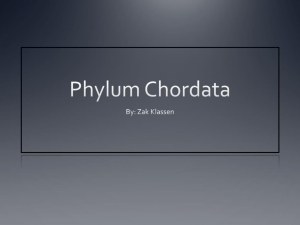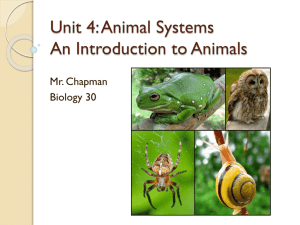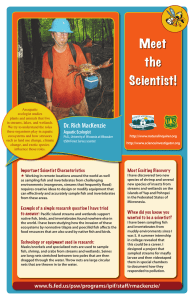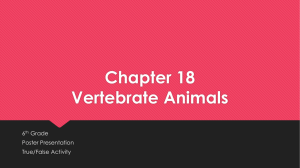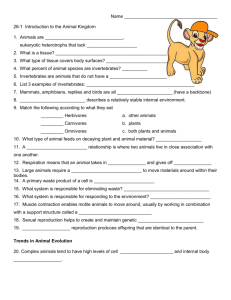Document 10789310
advertisement
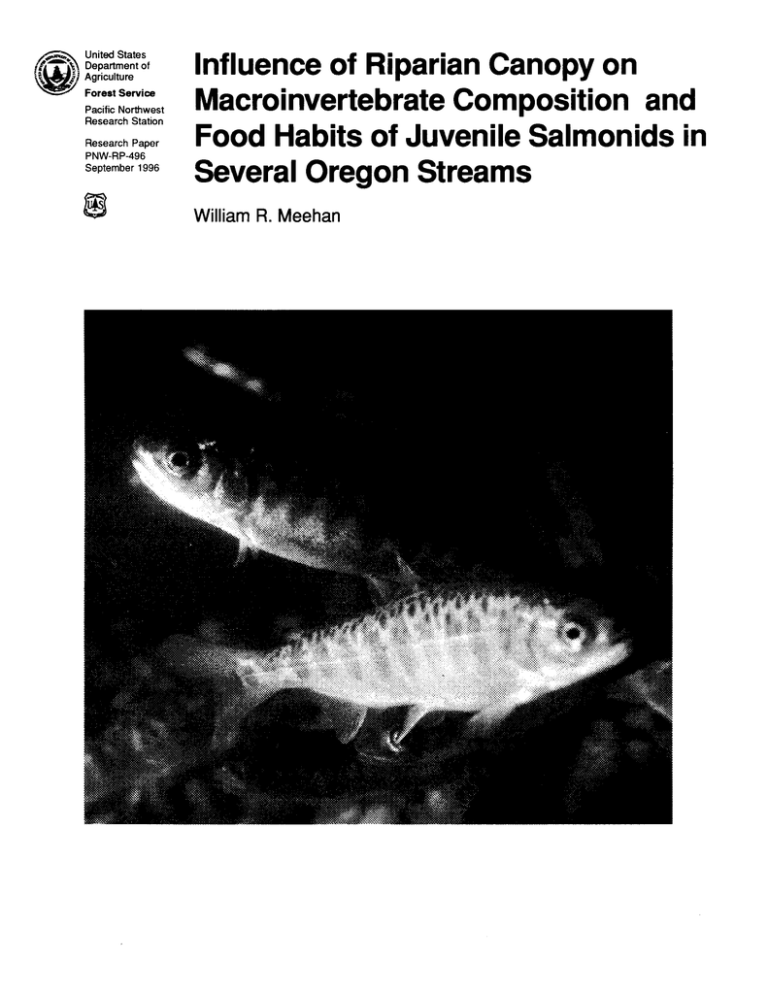
Author WILLIAM R. MEEHAN is a research fishery biologist (retired), Forestry Sciences Laboratory, 2770 Sherwood Lane, Juneau, AK 99801-8545. Abstract Meehan, William R. 1996. Influence of riparian canopy on macroinvertebrate composition and food habits of juvenile salmonids in several Oregon streams. Res. Pap. PNW-RP-496. Portland, OR: U.S. Department of Agriculture, Forest Service, Pacific Northwest Research Station. 14 p. The community composition of macroinvertebrates and the feeding habits of juvenile salmonids were studied in eight Oregon streams. Benthic, drift, sticky trap, and water trap samples were taken over a 3-year period, along with stomach samples of the fish. Samples were taken in stream reaches with and without riparian canopy. Both main effects—fish diet versus macroinvertebrate composition in the environment, and canopied versus noncanopied stream condition—were highly significant, but probably not of practical importance in terms of the amount of preferred food available to the fish. In all aquatic sample types, including fish stomachs, Diptera and Ephemeroptera were the predominant invertebrates collected. In sticky trap and water trap samples, Diptera and Collembola were the predominant orders, reflecting the input of terrestrial invertebrates. Keywords: Macroinvertebrates, community composition, salmonids, feeding habits, riparian canopy, Oregon. Summary Eight streams in Oregon were selected to study the community composition of macroinvertebrates and the feeding habits of juvenile salmonids. The streams were in coastal Oregon, along the west side of the Cascade Range, in central Oregon, and in eastern Oregon; thus they generally transected the State from west to east. The streams were second- to third-order streams and representative of the many small streams that provide rearing habitat for young salmon and trout. In each of the four geographical areas studied, two streams were sampled, and each had a reach with a canopy of vegetation over the stream and a reach without riparian canopy. Benthic, drift, sticky trap, and water trap samples, along with stomach samples of the fish, were taken throughout the year over a 3-year period. The data used in this analysis resulted from compositing the samples of invertebrates into four distinct categories: diets of fish in canopied and noncanopied stream sections, and the populations of macroinvertebrates present in the stream environment in canopied and noncanopied sections. Two simple main effects were considered—one associated with canopied versus noncanopied stream conditions, and the other with fish diet versus presence of the invertebrates in the environment. The interaction of these two effects also was evaluated. In all aquatic sample types, including fish stomachs, Diptera and Ephemeroptera were the predominant invertebrates collected. In sticky trap and water trap samples, Diptera and Collembola were the predominant orders, reflecting the input of terrestrial invertebrates. Both main effects—fish diet versus invertebrates in the environment, and canopied versus noncanopied stream condition—were highly significant (P≤0.01), but in terms of the amount of preferred fish food organisms available, the presence or absence of riparian canopy did not seem to be a major concern. Contents 1 Introduction 1 Study Area 2 Material and Methods 2 Aquatic Sample Types 3 Aerial Sample Types 3 Sampling Schedule 4 Identification of Organisms 4 Statistical Analysis 5 Results and Discussion 5 Statistical Analysis 6 Benthic 8 Drift 8 Sticky Trap 8 Water Trap 8 Fish Stomach Contents 11 Variation Among Sample Types 11 Fish Diet 11 Use of Traps 12 Conclusions 12 English Equivalents 13 Literature Cited This page has been left blank intentionally. Document continues on next page. east was sampled. All the study streams were second- or third-order streams, comparable in size, and representative of the small streams that furnish a large amount of rearing habitat for young salmon and trout. The study streams, by area, were: Coast—Tributaries of Five Rivers in the Alsea River drainage: Green River East Fork Green River Cascades—Tributaries of the Lookout Creek system, which drains into the McKenzie River: Mack Creek MacRae Creek Central—Tributaries of the Deschutes River drainage: Ochoco Creek Canyon Creek Eastern—Tributaries of the Grande Ronde River: Meadow Creek McCoy Creek In each of the eight streams, samples were collected from a reach with a canopy of vegetation over the stream, and a reach that was open. Canopy type ranged from mixed coniferous and hardwood forest in the coastal and Cascades areas to shrubs and grasses in the central and eastern areas. Stream substrates were generally similar and ranged from cobble to coarse sand. Material and Methods Aquatic Sample Types Benthic—Benthic samples were collected by using a modified Hess sampler covering a surface area of 0.09 m2. Two samples were collected from each study reach at the beginning and again at the end of a 16-day sampling period; the samples were preserved in formal alcohol (half 70-percent ethanol and half 10-percent Formalin). In the laboratory, invertebrates were sorted from the benthos, counted, and identified to the lowest taxonomic level possible (generally to family and, where feasible, to genus or species). After the invertebrates were sorted, the entire sample was freeze-dried and weighed on an analytical balance to the nearest 0.1 mg. Drift—Macroinvertebrate drift was sampled in each study section with a 280-µ mesh Nitex drift net.1 Nets were 46 cm wide, 31 cm high, and 76 cm long. One net was set in place at the lower end of each study reach for 24 hours at the beginning and end of each 16-day sampling period. Nets were placed in riffles or runs with the bottom of the net on the streambed and the top above the stream surface such that the entire water column was sampled. Samples were processed in the field and laboratory as described for benthic samples. 1 The use of trade, firm, or corporation names in this publication is for the information and convenience of the reader. Such use does not constitute an official endorsement or approval by the U.S. Department of Agriculture of any product or service to the exclusion of others that may be suitable. 2 Fish stomach contents—Fish were collected with a Smith-Root 12-v D.C. backpack electroshocker in each study reach at the beginning and again at the end of a 16day sampling period. During each sampling period, 10 fish, or as many as could be collected, of each salmonid species were captured. Fish from 50- to 150-mm fork length were used when possible, because complete flushing of stomachs of larger fish was difficult and error was more likely. Captured fish were anesthetized with Tricaine Methanesulfonate (MS-222), measured (fork length in mm), and weighed to the nearest 0.1 g on an analytical balance. Stomachs were then flushed (Meehan and Miller 1978) and the contents were preserved in formal alcohol. After reviving in fresh water, the fish were released back into the stream at the same location where they were captured. Aerial Sample Types Terrestrial insects and adult aquatic insects that dropped onto the stream surface were sampled during each sampling period by using sticky traps and water traps. A pair (one of each type) was located at each of two sites within each study reach. Sticky trap—Sticky traps were 31-cm squares of white-painted 6.35-mm plywood; each was covered with a piece of 6-mil clear polyethylene film. This square surface was sprayed with “Tree Tanglefoot,” a sticky substance used as a barrier to crawling insects on trees. Each coated board was taped to a Styrofoam float 36 cm square and 5.1 cm thick. Two sticky traps were placed in each study reach for the full 16 days of each sampling period. When the trap was removed at the end of the sampling period, the plastic film was cut off at the edges of the board so that a 31-cmsquare collection surface was retained, butcher paper was placed over the sticky side to prevent crushing or mold damage to the specimens, and this film and butcher paper “sandwich” was transported to the laboratory. In the laboratory, the butcher paper was removed and the film cut into 2.54-cm strips for viewing under a microscope. Insects were counted and identified, usually to the family level. Water trap—Water traps were made from 33- by 28-cm plastic dishpans, 13 cm deep, surrounded by a 61-cm rectangle of 5.1-cm-thick Styrofoam for support and floatation. Each pan was filled to about half its depth with water, and 28.4 g of formalin and 28.4 g of a surfactant (Ortho R X-77 Spreader) were added. The surfactant reduced surface tension and allowed insects to settle to the bottom. A small hole was bored into a lower corner of the pan and was fitted with a rubber stopper for easy removal of the contents. Two water traps were set out in each study reach for the full 16 days. When a trap was removed at the end of a sampling period, the corner plug was removed and the contents of the pan were strained through a 0.5-mm mesh screen. The material remaining on the screen was washed into a jar with formal alcohol and processed as described for benthic and drift samples. Sampling Schedule Each stream was sampled during summer and fall 1974 and during all four seasons in 1975 and 1976. Samples were taken at the following times: winter—mid January to early February; spring—early to late April; summer—early to late July; and fall—early October to early November. A sampling period was organized as follows: On day 1, sticky traps, water traps, and drift nets were set out. On day 2 (24 hours later), drift nets were pulled. During these 2 days, benthic and fish stomach content samples were taken. 3 Two weeks later, macroinvertebrates and fish were again sampled . On day 15, drift nets were set out, and 24 hours later (day 16), they were pulled. Sticky traps and water traps that had been in place during the 16-day period were removed. During these 2 days, benthic macroinvertebrates and fish stomach contents were again sampled. Because of ice and other weather-related problems, the winter sampling period at the central and eastern sites in both years, and at the Cascade site in 1976, was only one trip of 2 days rather than two trips over 16 days. During these shortened sampling periods, samples from sticky traps and water traps were not obtained, and only half as many of the other samples were collected. Identification of Organisms Invertebrates other than insects were identified through descriptions in Pennak (1978), Ward and Whipple (1959), and Burch (1982). Aquatic insects were identified from taxonomic keys in Hatch (1953, 1957, 1961, 1965, 1971), Usinger (1956), Jensen (1966), Cole (1969), Anderson (1976), Edmunds and others (1976), Baumann and others (1977), and Merritt and Cummins (1978). Terrestrial insects were identified primarily from Borror and others (1976). Amphibians and fish were identified from Stebbins (1954) and Bond (1973), respectively. Statistical Analysis To simplify the various analyses and comparisons, invertebrates were studied at the order level. Seven orders comprised the majority of the invertebrates collected, so these seven orders were listed individually, and the remaining organisms were lumped into the category “other.” Initial data analysis showed that in the four geographical areas, fish preyed on the available food items comparably; that is, in all four geographical areas, a particular order of invertebrates was fed on in about the same proportion relative to its percentage of occurrence in the environment. Therefore, areas (and years) were combined in the analyses. Likewise, no obvious differences in the feeding habits of the fish were seen between the two streams in each area, and so streams within areas also were combined. The data used in this analysis resulted from compositing the samples of invertebrates for four distinct categories: diets of fish in canopied and noncanopied stream sections, and the populations of macroinvertebrates present in the stream environment in canopied and noncanopied sections. The response variable was the number of macroinvertebrates in each taxon (order) that occurred in the composite sample within each of the four categories. The response variable can be viewed as a categorical variable with eight nominal categories; that is, a multinomial variable with eight categories, one for each invertebrate order. The purpose of the analysis was to compare the profiles of this response variable among the four populations described above. The profile was best presented as the set of percentages (or proportions) of invertebrates in each order group. These percentages were computed separately within each population. The profiles for the four populations were compared to determine whether the profiles were similar for canopied and noncanopied stream sections, and more importantly, whether the profile of fish diet was similar to the profile of invertebrates available in the environment. In fact, two simple main effects were considered, one associated with canopied versus noncanopied stream conditions, and the other with fish diet versus presence of the invertebrates in the environment. The interaction of these two effects also was evaluated. 4 Methods described by Agresti (1990) were used to compare these profiles. The generalized baseline-category logit transformation was applied to the profile percentages in each population. Diptera were consistently the most abundant invertebrates collected; hence, this order was used as the baseline category. The resulting transformed profiles were then compared by testing main effects associated with (1) fish diet compared to invertebrate populations available in the environment, (2) canopied versus noncanopied stream conditions, and (3) the interaction. All tests were based on maximum-likelihood methods for model fitting. Results and Discussion Statistical Analysis In comparing the profiles of the four categories (fish diet and invertebrate presence in canopied and noncanopied stream sections), these categories represent a twoby-two arrangement of treatment factors. One factor is riparian condition—canopy or no canopy; the other factor is fish diet versus invertebrates in the environment (tables 1 and 2). Fitting a model with both main effects and the interaction would describe the observed profiles exactly. Thus, a first consideration was the need for the interaction term in the model describing the transformed profiles. The interaction term was statistically significant, but the chi-square value associated with the interaction term (χ2=198, df=7) was relatively small compared to other sources of variation (table 3). Further, examination of differences in observed and predicted profiles, using only the main-effects model, indicated that the main-effects model fitted the data well, thereby confirming that the interaction effect was small from a practical perspective. Both main effects—fish diet versus invertebrates available in the environment, and canopied versus noncanopied stream condition—were highly significant (p≤0.01). This indicates that the profile of fish diet differed from the profile of invertebrates in the environment. And the profile for canopied sections differed from the profile for noncanopied sections. These profiles are contrasted in figures 2 and 3. Because climate and geographical factors differed greatly among the areas, the same analysis was run separately on each stream; the results were similar to those from the analysis using combined areas. Table 1—Number of invertebrates, by order, collected from fish stomachs (cutthroat trout, rainbow trout, coho salmon) Order Collembola Cutthroat trout Rainbow trout Coho salmon Total fish 165 70 471 706 Ephemeroptera 4,010 6,238 989 11,237 Plecoptera 1,412 1,602 345 3,359 Homoptera 158 3,570 282 4,010 Coleoptera 361 1,245 323 1,929 Trichoptera 1,715 2,560 492 4,767 Diptera 5,557 9,166 4,051 18,774 Other 1,497 2,511 746 4,754 26,962 7,699 49,536 Total 14,875 5 Table 2—Number of invertebrates, by order, collected from the environment (benthic, drift, sticky traps, water traps) Drift Sticky trap Water trap 49 34,905 16,593 213 10,724 8,866 25,612 5,492 307 20,554 9,343 5,740 3,172 3,084 13,572 3,109 20,213 911 977 2,845 1,015 1,980 37,072 1,125 13,579 464 773 1,788 1,527 1,174 22,903 3,029 34,148 56,834 27,686 10,586 16,438 15,104 99,159 12,755 102,454 58,881 66,138 45,237 272,710 Order Benthic Collembola Ephemeroptera Plecoptera Homoptera Coleoptera Trichoptera Diptera Other Total Total environment Table 3—Interaction-effect analysis of variance Source DF Chi-square Probability Intercept 7 99,560.16 <0.01 Environment vs fish Canopy vs noncanopy 7 7 7,861.90 3,496.50 <0.01 <0.01 Likelihood ratio 7 198.42 <0.01 Although the differences in profiles were statistically significant, the differences did not appear to be of practical importance. Notice, for example, the percentages of Diptera and Ephemeroptera—the two dominant orders of macroinvertebrates collected—in figures 2 and 3. For these two orders, the difference between treatment effects was small. The greater differences in other orders that are not as important as fish food organisms, such as Collembola and Homoptera, would account for most of the statistical differences found in the profiles (figs. 2 and 3). Benthic 6 Mayflies (Ephemeroptera) were the most abundant invertebrates in benthic samples in both canopied and noncanopied stream sections, followed closely by true flies (Diptera) and stoneflies (Plecoptera) (table 4). Table 4—Number and percentage of invertebrates, by order, collected in benthic samples in canopied and noncanopied stream sections Canopy Order Number Collembola Ephemeroptera Plecoptera Homoptera 15 16,591 8,295 162 0.0 34.6 17.3 .3 Coleoptera Trichoptera Diptera Other 5,873 3,692 10,674 2,637 47,939 Total Percent No canopy Number Total Percent Number Percent 34 18,314 8,298 51 0.1 33.6 15.2 .1 49 34,905 16,593 213 0.0 34.1 16.2 .2 12.3 7.7 22.3 5.5 4,851 5,174 14,938 2,855 8.9 9.5 27.4 5.2 10,724 8,866 25,612 5,492 10.5 8.7 25.0 5.3 100.0 54,515 100.0 102,454 100.0 Drift As in the benthic samples, ephemeropterans were the most abundant invertebrates found in the drift samples in both canopied and noncanopied stream sections, followed by dipterans (table 5). In canopied sections, plecopterans were the next most abundant; in noncanopied sections, however, homopterans were slightly more numerous than plecopterans. This abundance of homopterans in the drift in noncanopied sections was the result of a very high percentage of this order collected in the fall sampling in streams in eastern Oregon, particularly Meadow Creek (Porter and Meehan 1987: 36). Sticky Trap Dipterans were the most abundant invertebrates collected on sticky traps in both canopied and noncanopied stream reaches, followed by collembolans (table 6); ephemeropterans and plecopterans were the least numerous in both canopied and noncanopied sections. Water Trap Water trap samples were similar to sticky trap samples: in both canopied and noncanopied stream reaches, dipterans were the most abundant invertebrates, followed by collembolans (table 7). Fish Stomach Contents Cutthroat trout—In both canopied and noncanopied stream reaches, Diptera and Ephemeroptera were the most abundant taxa found in cutthroat trout stomachs, and Homoptera and Collembola were the least numerous (table 8). Rainbow trout—Rainbow trout stomach samples were similar to those of cutthroat trout: dipterans and ephemeropterans were the most abundant invertebrates found in both canopied and noncanopied sections (table 9) and collembolans were the least abundant. In both canopied and noncanopied sections, however, homopterans were quite abundant in rainbow trout stomachs. 8 Table 5—Number and percentage of invertebrates, by order, collected in drift samples in canopied and noncanopied stream sections Canopy No canopy Order Number Collembola Ephemeroptera 195 10,171 0.7 36.8 Plecoptera Homoptera Coleoptera Trichoptera Diptera 4,818 806 1,799 1,781 6,316 Other Total Percent Number Total Percent Number Percent 112 10,383 0.4 33.2 307 20,554 0.5 34.9 17.4 2.9 6.5 6.4 22.8 4,525 4,934 1,372 1,303 7,256 14.5 15.8 4.4 4.2 23.2 9,343 5,740 3,172 3,084 13,572 15.9 9.7 5.4 5.2 23.1 1,766 6.5 1,343 4.3 3,109 5.3 27,652 100.0 31,229 100.0 58,881 100.0 Table 6—Number and percentage of invertebrates, by order, collected on sticky traps in canopied and noncanopied stream sections Canopy Order Number Percent Collembola Ephemeroptera Plecoptera Homoptera Coleoptera Trichoptera Diptera Other 12,388 442 640 1,603 487 1,202 19,558 510 33.6 1.2 1.7 4.4 1.3 3.3 53.1 1.4 Total 36,830 100.0 No canopy Number Total Percent Number Percent 7,825 469 337 1,242 528 778 17,514 615 26.7 1.6 1.1 4.2 1.8 2.7 59.8 2.1 20,213 911 977 2,845 1,015 1,980 37,072 1,125 30.5 1.4 1.5 4.3 1.5 3.0 56.1 1.7 29,308 100.0 66,138 100.0 9 Table 7—Number and percentage of invertebrates, by order, collected on water traps in canopied and noncanopied stream sections Canopy Order Collembola Ephemeroptera Plecoptera Homoptera Coleoptera Trichoptera Diptera Other Total No canopy Total Number Percent Number Percent Number Percent 8,527 260 33.9 1.0 5,052 204 25.2 1.0 13,579 464 30.0 1.0 505 1,161 1,066 523 11,539 2.0 4.6 4.2 2.1 45.8 268 627 461 651 11,364 1.3 3.1 2.3 3.2 56.7 773 1,788 1,527 1,174 22,903 1.7 4.0 3.4 2.6 50.6 1,609 6.4 1,420 7.2 3,029 6.7 25,190 100.0 20,047 100.0 45,237 100.0 Table 8—Number and percentage of invertebrates, by order, collected from cutthroat trout stomachs in canopied and noncanopied stream sections Canopy Order Total Number Percent Number Percent Collembola Ephemeroptera Plecoptera Homoptera Coleoptera Trichoptera 65 1,743 639 52 167 814 1.1 28.5 10.5 .9 2.7 13.3 100 2,267 773 106 194 901 1.1 25.9 8.8 1.2 2.2 10.3 165 4,010 1,412 158 361 1,715 1.1 26.9 9.5 1.1 2.4 11.5 Diptera Other 1,919 711 31.4 11.6 3,638 786 41.5 9.0 5,557 1,497 37.4 10.1 6,110 100.0 100.0 14,875 100.0 Total 10 No canopy 8,765 Number Percent Table 9—Number and percentage of invertebrates, by order, collected from rainbow trout stomachs in canopied and noncanopied stream sections Canopy Order No canopy Total Number Percent Number Percent Collembola Ephemeroptera 27 2,845 0.2 25.2 43 3,393 0.3 21.7 70 6,238 0.3 23.2 Plecoptera Homoptera Coleoptera Trichoptera Diptera 915 1,089 668 769 3,782 8.1 9.6 5.9 6.8 33.5 687 2,481 577 1,791 5,384 4.4 15.8 3.7 11.4 34.4 1,602 3,570 1,245 2,560 9,166 5.9 13.2 4.6 9.5 34.0 Other 1,195 10.7 1,316 8.3 2,511 9.3 11,290 100.0 15,672 100.0 26,962 100.0 Total Number Percent Coho salmon—As with the cutthroat trout and rainbow trout stomach samples, true flies and mayflies were the most abundant invertebrates found in coho salmon stomachs in both canopied and noncanopied stream reaches (table 10). Percentages of the remaining taxa were fairly similar. Variation Among Sample Types In all sample types except sticky and water traps, dipterans and ephemeropterans were the predominant invertebrates collected; dipterans were somewhat more abundant than ephemeropterans, except in benthic and drift samples, where ephemeropterans were slightly more numerous. In the sticky and water trap samples, Diptera was again the most abundant taxon, but the second most abundant group was the collembolans. Collembolans were the least abundant invertebrates in all sample types, except sticky and water traps and coho salmon stomachs. Fish Diet Dipterans and ephemeropterans were the dominant invertebrates consumed by all fish species sampled, and in most cases, collembolans were the least used group. Because of the abundance of collembolans in the sticky and water trap samples, even though they were not found in abundance in the drift, it appears that the fish were probably negatively selective toward this taxon. Use of Traps The proportions of taxa found in sticky trap and water trap samples were relatively similar. Based on the results of this study, it appears unnecessary to collect both of these sample types if a general description of food items available in the environment and items eaten by fish is the final objective. Water traps are easier to work with than sticky traps, and the invertebrates are also in better condition. As a result, if the least amount of sampling possible is a prerequisite, sticky traps at the water surface could probably be eliminated from the sampling scenario. If differences in invertebrate abundance and composition above the air-water interface are sought, however, then sticky traps would be an important consideration. 11 Table 10—Number and percentage of invertebrates, by order, collected from coho salmon stomachs in canopied and noncanopied stream sections Canopy Order Number Collembola Ephemeroptera Plecoptera Homoptera Coleoptera Trichoptera Diptera Percent Number Percent Total Number Percent 166 412 4.4 10.9 305 577 7.8 14.7 471 989 6.1 12.8 163 147 180 264 2,094 4.3 3.9 4.8 7.0 55.3 182 135 143 228 1,957 4.6 3.4 3.7 5.8 50.0 345 282 323 492 4,051 4.5 3.7 4.2 6.4 52.6 359 9.4 387 10.0 746 9.7 3,785 100.0 3,914 100.0 7,699 100.0 Other Total No canopy In all sample types except sticky and water traps, total numbers of invertebrates were somewhat greater in noncanopied stream sections than in canopied sections. In sticky and water traps, the greater abundance of Collembola in canopied sections probably accounted for this difference from the other sample types. Conclusions The results of this study showed a significant difference between the profile of macroinvertebrates sampled in the environment and those taken as food items by fish, and between those stream sections sampled that had riparian canopy and those that did not. “Profile” in this case can be likened to invertebrate community structure. However, the two dominant macroinvertebrate taxa—Diptera and Ephemeroptera—did not appear to be much different from a practical standpoint; that is, in terms of the amount of preferred fish food organisms available, the presence or absence of riparian canopy did not appear to be a major concern. There were a few more dipterans and ephemeropterans in the noncanopied sections than in the canopied sections (fig. 3), but probably not enough to warrant a management prescription that would open up the riparian canopy for the sole purpose of providing more preferred food items for fish. English Equivalents 1 meter (m) = 3.28 feet 1 square meter (m2) = 10.76 square feet 1 centimeter (cm) = 0.39 inch 1 millimeter (mm) = 0.039 inch 1 micrometer (µ) = 0.000039 inch 1 gram (g) = 0.035 ounce 1 milligram (mg) = 0.000035 ounce 12 Literature Cited Agresti, Alan. 1990. Categorical data analysis. New York, NY: John Wiley and Sons (p. 306-313). 558 p. Anderson, Norman H. 1976. The distribution and biology of the Oregon Trichoptera. Tech. Bull.134. Corvallis, OR: Oregon State University, Agricultural Experiment Station. 152 p. Baumann, Richard W.; Gaufin, Arden R.; Surdick, Rebecca F. 1977. The stoneflies (Plecoptera) of the Rocky Mountains. Memoirs of the American Entomological Society. 31: 1-208. Bisson, Peter A. 1978. Diel food selection by two sizes of rainbow trout (Salmo gairdneri) in an experimental stream. Journal of the Fisheries Research Board of Canada. 35(7): 971-975. Bond, Carl E. 1973. Keys to Oregon freshwater fishes. Tech. Bull. 58. Corvallis, OR: Oregon State University, Agricultural Experiment Station. 42 p. Borror, Donald J.; Delong, Dwight M.; Triplehorn, Charles A. 1976. An introduction to the study of insects. 4th ed. New York, NY: Holt, Rinehart, and Winston. 852 p. Burch, J.B. 1982. Freshwater snails (Mollusca: Gastropoda) of North America. EPA600/3-82-026. Cincinnati, OH: U.S. Environmental Protection Agency. 294 p. Cole, Frank R. 1969. The flies of western North America. Berkeley, CA: University of California Press. 693 p. Edmunds, George F., Jr.; Jensen, Steven L.; Berner, Lewis. 1976. The mayflies of North and Central America. Minneapolis, MN: University of Minnesota Press. 330 p. Hatch, Melville H. 1953. The beetles of the Pacific Northwest. Part I: Introduction and Adephaga. Seattle, WA: University of Washington Press. 340 p. Hatch, Melville H. 1957. The beetles of the Pacific Northwest. Part II: Staphyliniformia. Seattle, WA: University of Washington Press. 384 p. Hatch, Melville H. 1961. The beetles of the Pacific Northwest. Part III: Pselaphidae and Diversicoria I. Seattle, WA: University of Washington Press. 503 p. Hatch, Melville H. 1965. The beetles of the Pacific Northwest. Part IV: Macrodactyles, Palpicornes and Heteromera. Seattle, WA: University of Washington Press. 268 p. Hatch, Melville H. 1971. The beetles of the Pacific Northwest. Part V: Rhipiceroidea, Sternoxi, Phytophaga, Rhynchophora and Lamellicornia. Seattle, WA: University of Washington Press. 662 p. Irvine, J.R.; Northcote, T.G. 1982. Significance of sequential feeding patterns of juvenile rainbow trout in a large lake-fed river. Transactions of the American Fisheries Society. 111: 446-452. Jensen, Stephen Leroy. 1966. The mayflies of Idaho (Ephemeroptera). Salt Lake City, UT: University of Utah. 352 p. M.S. thesis. 13 McNicol, Richard E.; Scherer, Eberhard; Murkin, Elaine J. 1985. Quantitative field investigations of feeding and territorial behaviour of young-of-the-year brook charr, Salvelinus fontinalis. Environmental Biology of Fishes. 12(3): 219-229. Meehan, William R.; Miller, Richard A. 1978. Stomach flushing: effectiveness and influence on survival and condition of juvenile salmonids. Journal of the Fisheries Research Board of Canada. 35(10): 1359-1363. Merritt, Richard W.; Cummins, Kenneth W., eds. 1978. An introduction to the aquatic insects of North America. Dubuque, IA: Kendall/Hunt Publishing Co. 411 p. Pennak, Robert W. 1978. Fresh-water invertebrates of the United States. 2d ed. New York, NY: John Wiley and Sons. 803 p. Porter, Pamela E.; Meehan, William R. 1987. Seasonal species composition of invertebrates in several Oregon streams. Res. Pap. PNW-RP-382. Portland, OR: U.S. Department of Agriculture, Forest Service, Pacific Northwest Research Station. 36 p. Stebbins, Robert C. 1954. Amphibians and reptiles of western North America. New York, NY: McGraw-Hill Book Co. 528 p. Usinger, Robert L., ed. 1956. Aquatic insects of California. Berkeley, CA: University of California Press. 508 p. Ward, Henry Baldwin; Whipple, George Chandler. 1959. Fresh-water biology. 2d ed. New York, NY: John Wiley and Sons. 1248 p. 14 This page has been left blank intentionally. Document continues on next page. This page has been left blank intentionally. Document continues on next page. U.S. Department of Agriculture Pacific Northwest Research Station 333 S.W. First Avenue P.O. Box 3890 Portland, OR 97208 Official Business Penalty for Private Use, $300 do NOT detach label
